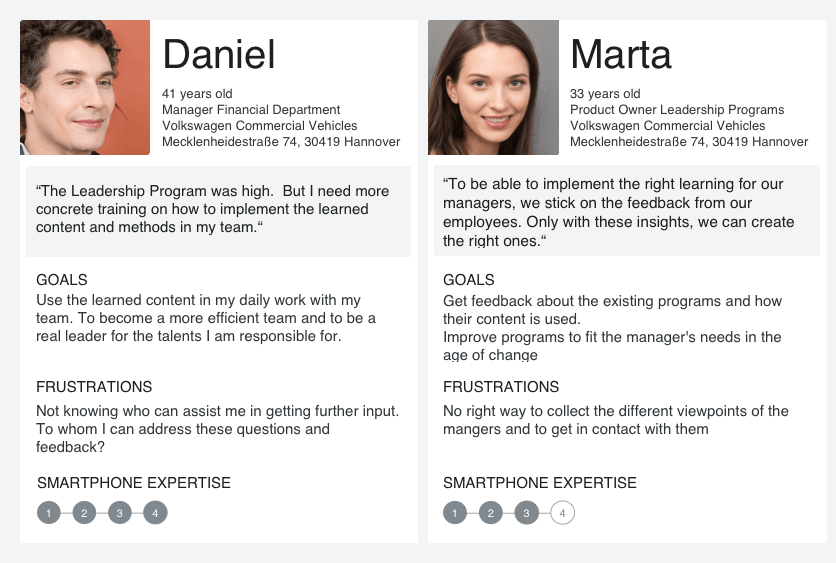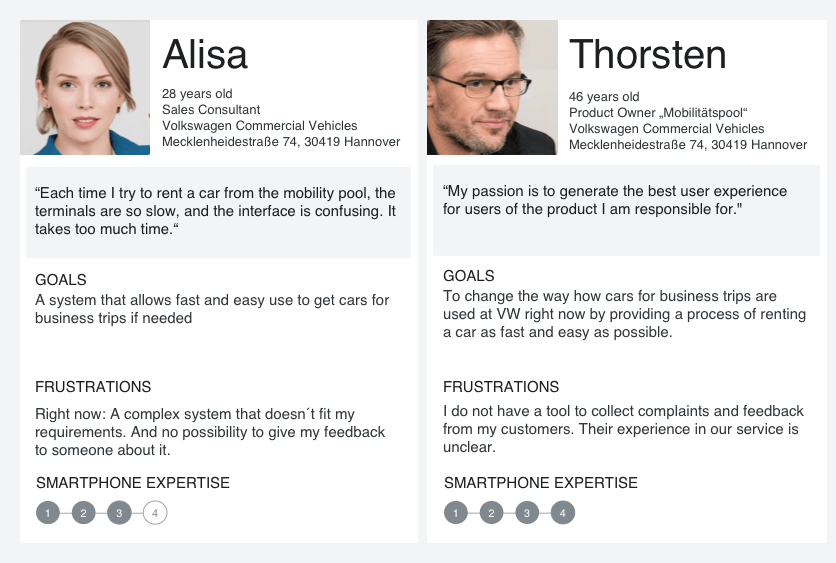
Today, one of the most exciting industry fields is the automobile sector. Actual this industry sector is faced with a highly disruptive, fast-changing market with a huge amount of new players. Therefore the long-established companies try to change their internal culture and focus on “agile”, “customer-centric product development” as well as on “transparency” to remain competitive.
These buzzwords are not only useable for the external appearance of a company, but they are also totally required for the internal behavior of a company. They help to reorganize old-fashion, untransparent internal processes, services, or products. Based on the challenge, to adapt long-established interior services to speed-up the workflow of employees, the question arises how such an adaption can be supported? Of course, the change of a culture does not come overnight -cultural change is a long-term process. But are there tools that can help to achieve a cultural transformation?
Collecting feedback in a transparent, open way and linking the given input to the responsible person, can lead to a changing mindset. Next, to the hard measurable aspect of cultural change, which is related to the way how feedback is collected and treated, the input itself utilizes a lifetime ongoing improvement process. Neither for IT-services or human-based processes, feedback from users is required.
In my last project at VW Commercial Vehicles, I released an app-based digital tool, called VOICE, that supports employees in sharing ideas and giving feedback or suggestions. In this blog post, I will provide you a rough introduction about how this feedback platform works and what I aim to achieve.
We will first start with a presentation about how the idea of this specific platform arises and how it maybe could help to be more “customer-focused”. After this, I will explain the UX-architecture of VOICE and give some little examples. A short discussion follows about
how the company culture is affected by collecting, sharing, and talking about feedback. At least a small conclusion will be given, which round off the blog post.
Introduction – Finding a disruptive idea for internal products, services or processes
In general, I had the idea of this kind of feedback platform some years ago, but it is hard to get investment money for something like feedback. Because it is difficult to determine a reliable return on investment on such a topic. Of course, someone could calculate how high a collected and assigned feedback to the corresponding Product Owner (PO) of a process or service lead to an improvement of the offered service. This improvement may also provide time-saving to employees using these services. However, doing this beforehand is like “pee in the snow” – because estimating the impact of feedback to a return on investment by using a new digital platform is very fuzzy.
But in mid-2017 Volkswagen Commercial Vehicles (VWN) started his program WEsion which stands for “WE Strategie Innovation Orientierung Nutzfahrzeuge”. The idea of this seminar was to find young talents at VWN and give them a handful of difficult questions about the aimed cultural change like:
- How can new opportunities for VWN employees arise in the digital revolution? How can new technologies make work more efficient, more accessible, happier, and better for individual employees?
- In times of change, creativity is needed. This also takes time. Where can rooms be created at VWN to allow time for creativity?
- We have so much innovation potential through our employees. How can we integrate these thoughts and ideas into the work process?
The goal was, to think about concepts, how these questions can be answered. Together with the Business School HEC Paris, these young talents work in eight different groups on their ideas. The objective was to pitch the prepared concept in May 2018 in front of the VWN board to get a “go and budget” to start the experiment of implementing the developed approach.
With the different modules of the seminar, based on the very well learning journey by Odyssey 3.14, my group decided to pick up the idea of a feedback platform to answer the questions mentioned above. Therefore we used a structured way to collect the problem statement and generate a red thread. Starting now, I would like to give you some aspects of this red thread together with different used templates to figure out the added value of the idea.
Problem Statement
Nowadays, it is essential to react quickly to customer requirements due to increasing competition. Therefore, Product Owners must have an easy way to capture the needs and feedback of their customers. This is the only way to achieve, improve and maintain a high level of customer satisfaction. Product Owners often do not have good opportunities to ask their users about product and service weaknesses. Supplementary users often do not know precisely to whom they can address their feedback and wishes. There is no application today that connects both sides to collect input in a targeted way.
Value Proposition
Based on the problem statement, the value proposition thematizes two central issues here:
- Firstly, the value proposition describes what value is delivered through a particular product or service.
- Apart from that, dealing with the value proposition means to point out all different stakeholders (inclusive the client) of the product or service.
In the following subchapter, the value proposition of the digital feedback platform “VOICE” will be presented. A quick overview of VOICE and its target group can be already discovered by using the “What? For Whom? How?” template which is presented in figure 1.

What?
VOICE is an app-based digital tool. It supports employees in exchanging ideas and giving feedback or suggestions on the used services. The platform makes it possible to integrate employee opinions, wishes and recommendations into the work process. VOICE enables employees to participate in the improvement of products and processes actively. The collected feedback is an essential source of innovation. On this basis, Product Owners can bring improvements or new functions to the market. The feedback can also be used to make adjustments to the current offering in order to increase employee satisfaction and thus internal efficiency – because the respective product will be improved. VOICE helps Product Owners to become aware of their employees’ problems. Figure 2 summarizes this VOICE innovation cycle.

Figure 2 shows, first of all, that there is a problem or feedback to an internal service, process or product. Before anyone can enter data via VOICE, they have to register in the app – anonymous feedback is not possible. In this way, negative, non-constructive entries can be prevented. The app-based solution makes it possible to share a specific problem or suggestion at any time and not have to wait until you have access to a computer again. To capture a particular problem in VOICE, the user selects the appropriate service, process or product. The user determines the form of feedback. Once the input has been entered, it is forwarded to the Product Owner responsible. He answers or informs the user about the implementation of the proposed improvement.
For Whom?
Today, big companies contain a vast amount of internal processes, services, or products that they offer their employees to guarantee a smooth operation. Some of these provided services may have a technical system to supply a user interface, whereas others may only contain human-based processes. As an example, two services provided by Volkswagen Commercial Vehicles to their employees are listed:
- Leadership Program: To learn necessary leadership skills the Human Resource department offers a high-quality seminar, which also aims to start a shift in the mindset of the participants. Next to this seminar, the participants can use services to be supported to try out the learning objectives.
- Mobility Pool: The Mobility Pool is an internal car-sharing platform which enables the employees to book a car for a business trip easily. The booking platform is realized as a web application that is connected to key-storage boxes. After a booking is confirmed, employees can pick up the car-key in the key-storage box and take the car from the parking lot.
The services mentioned above should give a rough clue about the variety of independent services. Nevertheless, by being faced with a disruptive, fast-changing market, the internal processes, services, or products which should enable a smooth operation to employees underlie also this external pressure. It is essential, by increasing competition, to react fast to the requirements of costumers. Employees, which use internal services to fulfill their job act like customers to the occupied service.
Thus the target group for VOICE is all employees at Volkswagen Commercial Vehicles as well as the Product Owners of services, processes, or products which provide their application to the employees. These are summarized in the form of the following personas for the itemizes two examples. In each context of use, the employees, as well as the Product Owners’ perspective, is juxtaposed and described. In the form of the “personas” it becomes even more apparent, that both sides can profit through a feedback platform like VOICE.
Example – Leadership Program

Persona Marta is responsible for the successful implementation of the Leadership Program and would like to receive feedback to improve the program. The following questions would be of interest to Marta:
- Is the offered program the right training?
- Are the contents helpful?
- Is the way of working changing?
Every time she asks participants of the workshop, she gets the answer that the workshop was excellent. However, Marta asks herself: Is that the opinion of all participants? Because the programs are expensive and Marta wants to invest in the right lectures. Therefore, a tool is needed with which Marta can receive feedback on her questions and many impressions.
On the other hand, there is Daniel, who was a participant in the program. He was impressed by the program and wants to share his feelings. At the same time, he doesn’t know how to put the learned content into practice in his team. Therefore he would like to share his problem but does not know how and who is interested in his feedback.
By using the app, Marta can get feedback on the leadership program from all managers anytime, anywhere, quickly and easily. She can respond to Daniel’s input and will receive an enormous number of other responses from participants that she can include in her future projects. These are truly representative samples that can be analyzed using statistics, and the findings can be traced back. At the same time, Daniel has felt rewarded and motivated since Marta responded to him.
Example – Mobility Pool

With the Mobility Pool, everyone has the same goal: they want the interface of the Mobility Pool to be convenient and straightforward to use. Feedback is necessary to adapt this service to the needs of the employees. To collect this feedback, Thorsten wants to use the VOICE app as Product Owner. This platform allows an employee like Alisa to communicate her problems and obstacles around the Mobility Pool. Alisa realizes that the terminal’s touch screens don’t work correctly every time she tries to rent a new car. She can be one of many employees who have the same problem. By being able to share her impression of the app, Thorsten gets an idea of how his service works and arrives. He has a source where all feedback is collected and receives representative samples to use.
How?
When we talk about long-established companies, the topic of feedback has a unique viewpoint. A feedback platform like VOICE has, on the one hand, to utilize employees to give feedback and on the other hand, build up trust to the Product Owner side.
In general, the ecosystem of long-established companies – neither an IT ecosystem or not – is complicated. Think about your company where you are employed – do you have ever had trouble with the business trip system, and do you know to whom address your feedback? Often the Product Owner of an offered service is not transparent.
Additionally, collecting feedback would break up the silo of this specific service and could make weaknesses transparent and disclose. If a companies culture is not open-minded, this could cause fears of the responsible Product Owners. These concerns need to be addressed by building trust in the platform.
For the employee’s side, giving feedback have a high psychological threshold. In most cases, unforeseen effects or failures accrue in a situation when the users are on their own. Reporting these effects is essential for the Product Owner of a particular service, process, or product. Bringing a customer to the point of publishing the system behavior or an idea, is challenging. Because of the reporting time cost and effort on the user side without having a direct benefit from it. Therefore, the energy required to compile and transmit the feedback must be low. Additionally, the user has to be able to give the input anywhere and anytime. Thus reduces the threshold of using a fixed system (i.e., a website which is only reachable from the desktop pc).
Capturing feedback from users by mobile devices is a known research field in software engineering. Schneider et al. (Feedback in Context: Supporting the Evolution of IT-Ecosystems, Focusing spontaneous feedback to support system evolution and ConTexter feedback system) presents various approaches to collect spontaneous feedback by embedding it automatically into the surrounding context of the feedback provider. The described tool, called ConTexter, aim the business interest of focused feedback to competitive product aspects. As the authors emphasize “..user involvement is not a value per se: A provider company is not necessarily interested in building a social community, or in monitoring unconstrained discussions beyond the scope of the system. Unlimited and unfocused feedback will quickly exceed a software companies ability to analyze what has been sent”. The digital feedback platform VOICE adopts a little different viewport: On the one hand, it is necessary to focus and cluster the feedback given by users, and on the other hand, a capturing feedback tool needs the possibility to provide the users with space for a bidirectional exchange. To overcome this small threshold between unlimited, unfocused feedback and a two-way exchange, the application VOICE put the following three points in the forefront:
- Mid-Focused, guided, feedback: Collecting feedback to internal processes, services, and products by defined categories for each topic. It leads to a fast and natural interaction with the application.
- Automatically assignment: The provided feedback of a user in a selected area is automatically assigned to the corresponding Product Owner of the chosen service.
- Enable bidirectional communication: To enable the Product Owner of a topic to get further information about the feedback or to explain why an idea of a user can not be directly integrated, a multi-user chatroom is opened for each feedback. Furthermore, a provided response from the Product Owner with explanations and insight to the feedback creator helps them to understand better how the input is treated.
Why? – Value Curve
At least I would like to show the so-called “Value Curve”, which helps to underline why a specific change should be made. A Value Curve is a simple qualitative statement. But it helps to figure out where the new idea has its benefits and where an old approach has its weakness.
To start with a Value Curve, it is necessary to be aware of the different criteria which are used to compare the new way with the old one. Based on the definition of the specific rules, a qualitative statement can be determined. Of course, it is necessary to have in-depth knowledge (i.e. by making user experience tests) of the used approach of the competitor. The qualitative statement on each criterion gives an overview and arguments “why” an idea should be implemented.
In the case of the feedback platform VOICE, I have analysed the feedback culture of VW in the past (without VOICE) and the changes that will come with the implementation of VOICE. Therefore the following different criteria have been defined:
- Speed
The speed of the app is critical to the employees’ use. The faster the application is, the more frequently it will be used by the employees, and the less this usage leads to frustration due to long waiting times. - Usability
An app must be easy to handle, so all employees can use it easily and do not have to spend too much time getting used to it. The more natural the usability, the more the app is used by different employees from all age groups. - Scope
The scope of the app depends on its content. The app should include all relevant information the users need. A wide range of the app may overwhelm the user and lead to disapproval of the app. - Open Communication Policy
The communication policy aims to design dialogue between all stakeholders to create corporate goals. The more open the communication policy in the company is, the more the purposes of a large organization can be implemented comprehensibly and effectively. - Error Management
Error Management is the solution-oriented control of all activities, referring to errors. A culture of mistakes shapes the entire corporate culture and detects mistakes during an ongoing process and corrects them continuously. It creates a dynamic process of change and learning. - Corporate Culture
Organizational culture is the sum of behavior and its expressions that make the company tangible both internally and externally. The corporate culture influences the feedback behavior of the employees insofar as an open culture also allows free and neutral handling of feedback. The higher the versatility of the company’s culture, the better it is prepared for the changes in the future. - Goal Orientation
The goal orientation of an employee or supervisor influences his handling of feedback. The more goal-oriented a person gives out feedback, the more efficiently the ideas and suggestions can be implemented. - Comprehensibility
The more understandable feedback can be distributed, the easier the recommendations can be performed by the employee. - Solution Diversity and Quality of Improvements
In solution-oriented work, one immediately focuses on possible solutions to the current problem instead of dealing with the problem of finding out about the issue. - Objectivity
Objectivity refers to the independence of the assessment of a matter. Through objectivity, feedback can be conveyed free of judgemental tendencies.
With these categories as a basis, the following Value Curve in figure 5 can be determined. It shows that VOICE will have an impact on various aspects referring to the feedback process within the company.

The comparison in the Value Curve shows the differences in the feedback culture. In the past of Volkswagen, the feedback process was characterized by a slow transition process. Feedback on internal products, services, or processes was obtained by e-mail, telephone, or written surveys. It resulted in a lack of transparency and the disadvantage that employees do not have a specific contact person for their feedback. The consequence was a long communication process with many interfaces, whereby a fast process could not be guaranteed.
VOICE – bringing feedback creators and feedback receivers together
The app VOICE introduces a new way of how to give, see, follow, share, and rate feedback on its midpoint. It enables users to provide input whenever an issue appears, and it allows Product Owners to use this feedback to innovate and change their products or services. To sum up, VOICE is a straightforward and fast way to collect, aggregate, and transfer feedback between customers and product providers. In the case of VWN, the employees (customers) and the responsible person of the VWN internal products (Product Owner) are the players who benefit from VOICE. To be able to guarantee an easy and fast feedback report, as well as efficient access to the feedback-collection, VOICE is available app-based.
At the moment, the Product Owner often has a lack of information to improve its products and services. Also, the users don’t know precisely to whom they can address their feedback and wishes. Right now, there is no application to connect these sides to report and collect feedback easily. The application VOICE solves this problem as feedback can be given, seen, followed, shared, and rated on its midpoint. It enables the users to provide input whenever an issue appears, and it allows Product Owners to use this feedback to innovate and change their products and services.
Can feedback change a companies culture?
High speed in the feedback process is especially crucial to give a reply to the feedback creators. With VOICE, this speed can be achieved compared to other feedback processes (1). Feedback is often given when something is not working. In most cases, the mind is already upset – therefore, the app must ensure simplicity and usability (2) to make the feedback as easy as possible. Also, the scope (3) is adapted to the employees. This scope of the app allows fast integration. An open communication policy (4) supports the feedback process and creates a better understanding among the employees. In Volkswagen’s past, it was difficult for some employees to approach challenges openly and communicate solutions directly. Thanks to sophisticated error management (5), feedback processes are more solution-oriented. This solution-orientation helps to reduce error barriers. Errors can also be better avoided if questions are clarified in advance, and challenges are tackled more quickly. VOICE supports and improves the implementation of active fault management, so that knowledge sharing takes place through direct communication. A corporate culture (6) influences the feedback behavior of the employees so that an open culture also enables the neutral handling of feedback. A goal orientation (7) in the feedback process makes it possible to solve challenges more comfortably and quickly. Comprehensibility (8) and the understanding of a new approach to feedback are essential to bring about cultural change and to accept the new processes in the future. The more solution-oriented (9) a company works, the more honestly the feedback can help to solve current problems. VOICE will enable employees to provide neutral and objective input (10) that can mostly rule out personal assessments. In VW’s past, objectivity could not be consistently taken into account in decision-making processes. Especially in meetings, where many relevant discussions take place, a neutral point of view was not always available. With the help of VOICE, this objectivity is applied to decision-making processes. Private chats (see UX architecture) enable feedback to be communicated directly and without personal evaluation.
What do you think? Lead these points to a change in the culture of a company?
The UX-architecture of VOICE
Getting feedback is a tricky business. As you can read in the papers quoted above, the communication of feedback has a psychological hurdle: As a user, you don’t get anything out of it at first. Therefore, it is essential that, especially in situations where something goes wrong, feedback on the problem can be given quickly and easily.
Basically, VOICE distinguishes two different rolls: The so-called feedback creators and the feedback receivers. The feedback receiver is a Product Owner of a special product, service, or process. The feedback creator is a user who gives feedback on a specific product, service, or process. Thus, VOICE is the platform that connects both parties. Of course, a feedback receiver can be a feedback creator himself – but not for his product. Feedback receivers, the POs of a product, are especially highlighted in the application – this increases transparency and places the responsible persons of a product in the foreground.
The main navigation points in “Voice” consists of the following core functions:
- Feeds
The feed section provides an overview of all feedbacks in the system. You can filter them by category, timestamp, or ratings. Furthermore, you can watch the feed in a detail-view, share it,rate it, or follow them. Every feedback is transparent – you can see who has created it and to whom it is assigned (the Product Owner of the application the feedback belongs to). - Chats
In the conversations section, you can communicate with other employees via classic chat interaction, send messages and media content, and view the other’s profile. Every single chat always refers to a single feedback post. The idea is to bundle all the exchanges in one place. - Add Feed
Add allows you to create a new “post” by first selecting the primary category (choose the product you want to give feedback) and then the subcategory (this are different parts of the product determine with the Product Owner of the product/service/process). Afterward, you can write a title and description, add optional media content to your feedback, and publish it. Your feedback will be assigned to the Product Owner of the chosen category and is visible for all users of VOICE in the “Feed” menu. - Settings
Through this menu, several preferences can be adjusted by the user. It includes functions such as the password changing or resending process. Besides, information about VOICE itself, the code of conduct, the privacy policy, the imprint, the licenses or data protection, the release notes, and support possibilities are placed here. - Account
The account menu gives you functions to change your user avatar image and provides further profile information of your activities in the app.
The UX architecture of the application briefly outlined here is intended to convey a minimal impression of the use and highlight the most crucial navigation points. It becomes clear that the feedback, the responsible Product Owners, and the exchange of feedback were the main goals of the application. Nevertheless, the community idea is taken up feedback cannot be given entirely unstructured – the feedback creator must select a category and subcategory in the navigation point “Add Feed” before free feedback on the chosen topic can be given.
The three main lines listed in the “How?” section are to be implemented directly by the user guidance.
Summary
Based on the argumentation above, and with the right initial mindset of some projects, I believe that feedback can lead to a change in company culture. The experience at Volkswagen Commercial Vehicles shows that there are a lot of Product Owners who want to receive feedback. The only way to build and improve the product is to know how customers are getting their job done. Interviews and observations help to get this understanding. But having “an open ear” to complains or ideas of your customers will help you get a deeper understanding. Besides, you will get closer to your users by receiving their impulses and answering them.
In this blog post, you got a little introduction to the project “VOICE”, I started at Volkswagen Commercial Vehicles. The Problem Statement, as well as the Value Proposition, have been described. The used framework (What? For Whom? Who?, Lean Canvas, Lean Curve and Personas) to evaluate the product potentials and likely stakeholders have been shown and exemplified. Additionally, a short overview of the UX-Architecture of “VOICE” followed.
A part of the attention right in the blog post is also on the impact of feedback on corporate culture. A part of the attention right in the blog post is also on the impact of feedback on corporate culture. Of course, this is difficult to measure and quantify – especially since the VOICE application is only just being made available to employees of Volkswagen Commercial Vehicles. Maybe I will go into it in a future blog post when I get feedback and insights from my former colleague.

Acknowledgement and Templates
For bringing the idea to a real VW project, I would like to thank the team: Alexander Dreymann, Finja Mari Gorissen, Lara Symolka, Charlotte Marta Heering , Franziska Pfingsten, Victoria Perez-Aradros Obis, Kasem Jammoul, Christian Vogeler, Sören Schulz and Sebastian Cramer. And the whole team from the SoftwareDeveopmentCenter::Pune (especially Vaibhav Metha and his team for the great support and work). Thank you all for the great time and your assistants.







[…] realized by HEC Lausanne as successor program of WEsion (see as well the post “Can feedback help companies to change their culture?“)) to provide management with the right tools and understanding. On the other hand, with the […]